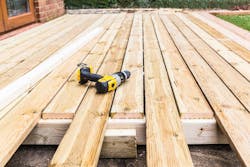20-Year-Old Decks: Repair or Replace?
The rails jiggle, the nails are popping, and Dad just limped in with a splinter.
Softwood decks can last a long time, depending on how well they’re built, but it’s not uncommon for decks of cedar, pine, or redwood to hold up for 10 to 20 years, at which point they begin to disintegrate in ways that range from unsightly and inconvenient to downright dangerous. “I’ve seen decks built two years ago that we couldn’t do anything with,” says Phil Brown, owner of Archadeck of Central Connecticut in Wallingford, “and decks built 50 years go where the frame was perfectly fine.”
Deck owners can sometimes only afford repairs, which typically means replacing the deck boards and railings. The last thing they want to hear is that they have to replace everything. But sometimes there’s no choice. Failing siding or windows may look bad or leak, but a failing deck can collapse. Someone injured in a deck collapse—6,500 people have been since 2003, according to a Chicago Tribune story two years ago—can sue the homeowner for damages. The Atlanta law firm Kalka & Baer even advertises deck collapse litigation as one of its specialties. And if someone sues, that would quickly become the deck contractor’s liability.
What’s Obvious, and What Isn’t?
Publicity around deck collapses has prompted many municipalities to tighten up deck construction standards before permits are issued. “Today, “they’re big on strapping things down,” says Lou Pagnutti, whose Decks Unique in Commack, NY, has been building decks on Long Island for decades. Still, on Long Island, which is full of homes built in the last fifty years, Pagnutti estimates that about half his deck calls involve a request to replace the boards and rails on an existing structure, i.e., a re-deck. “We inspect the understructure,” he says, which typically involves removing deck boards. “If it’s an iffy situation, we replace it.”
The price difference between replacing decking and rails vs. rebuilding from the ground up is often significant. Price is “always a tough question,” says Bryan Miller, president of Outback Deck in Woodstock, Georgia. For instance, if a homeowner merely wants new connectors and deck boards on a 12-by-15 foot wood deck, that might be “a $3,000 to $4,000 gig.” Tear the whole thing down—demo, dumpster rental, haul away, new lumber—“that could easily be $9000 or $10,000, maybe $12,000 or $15,000 or more if they want a much higher end product, like a Brazilian hardwood and expensive rails.”
Miller says Outback Deck will “do a major repair, if it’s a young enough deck that we feel confident” can be re-planked and a new rail system added without compromising the security and stability of the structure. “Young” means five to eight years old.
Checking Five Criteria
“Most people will ask: how much is it going to cost and when can it be completed,” Miller says. “What we know is that we need to think about it differently.”
The Atlanta company sticks to the book, using a six-page deck inspection form from the North American Deck and Rail Association (NADRA). The inspection focuses on five specific areas, three of them, Miller says, having to do with “points of connection to the support posts or to the house.” That is, post-to-footing, post-to-band, and band-to-house. In addition, the inspection looks at stair and guardrail connections. The idea is to determine if the deck is “failing”—deteriorated but still sound—or actually at risk of collapse. That information, once determined, is augmented with “photos of decks in failure and decks in collapse,” Miller says. “We talk about the importance of understanding the nature of the current structure and why it should be replaced.”
Comparing Deck and Frame Lifespan
Outback Decks is not opposed on principle to “salvaging” an older deck. But the company has developed systems that steer it away from situations that contain liability for the builder. NADRA executive vice president, Mike Beaudry, estimates that about half of the 50 million U.S. decks are at least 20 years old. Reputable deckbuilders have to have a method of assessing the usable life of a deck, and a policy for determining when its safe to repair rathere than replace it.
When California contractor Andrew York, owner of Pro Deck Construction, gets a call about repairing a deck, often enough it’s “20 years old and the redwood is worn out. It’s seen its life.” The condition of the frame, York says, will determine whether or not the deck can be salvaged. If the framing material isn’t pressure-treated, and if it’s unpainted, generally it’s a lost cause.
York say that when he goes to a job where “they just want to do the decking instead of the entire frame, I explain that there are 5 to 10 years of life in the frame, that the new deck will cost X and last however long, and that they can replace the frame for X much more and it will last the life of the decking.” If they’re looking to save money, York says, they will go with just replacing the decking, but “I make sure that it’s understood that we are just doing the decking portion so we are not responsible if this deck fails. I make that clear in the scope of work.”
Re-framing involves “a pretty significant cost difference” due to various parts of the area being at high risk for fire. At Pro Deck Construction, a standard deck plan has to meet the San Diego County fire code, which involves use of heavy timber framing on the theory that “bigger framing members are slower to ignite.” For York, such situations become an opportunity to suggest steel framing, which he estimates 10 percent of replacement customers opt to use.
Sound Frame, Crappy Decking
About 25 percent of the calls Brown gets involve repair. “Our rule of thumb is, if the framing is sound but the decking is crappy, which happens a lot, we will do everything we can to re-use as much of it as possible.” Brown says that “35 or 40 percent” of re-decks are in pretty good shape. But if the homeowner wants a heavier deck board—a composite, say, which is typically double the weight of wood—or a decorative design, then the company may need to create additional framing support. “If it’s a simple deck and they want to turn part of it into a porch, we have to add footings.” But if repairing the frame only saves a few grand, “you might be better off replacing the whole deck.”
Miller says that, whereas Outback Deck began by marketing its willingness to engage in deck repair, today that’s harder to do. A typical call might be someone planning to sell the house who simply wants the deck put into presentable shape. It is, he says, almost its own business. “If you’re going to run deck repair and advertise, you can expect 75 calls a month and you have to have a process to send a guy out and sell that job and do that repair on the spot and move to the next one,” he says. The current Atlanta labor market makes that almost impossible: “Finding guys who can run deck repair isn’t easy.”

